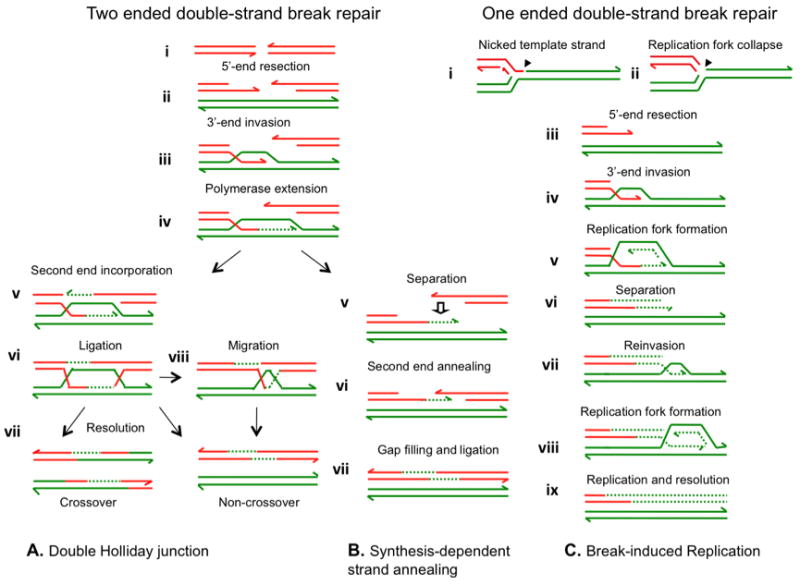Figure 2.

Mechanisms of homologous recombination. A and B Double-strand break repair; C. Double-strand end repair. A. Double Holliday junction recombinational double-strand break repair. At the break (a), 5′ ends are resected (b) to leave 3′ overhanging tails (half arrow heads). These are coated with RecA/Rad51 that catalyzes invasion by one or both ends into homologous sequence forming a D-loop (c). The 3′ end then primes DNA synthesis (dotted lines) that extends it past the position of the original break (d). The second end is incorporated into the D-loop by annealing, and is also extended (e). Following ligation, which forms a double Holliday junction (f), the junctions are resolved by endonuclease (g). The overall effect will be either a non-crossover or a crossover, depending upon whether the two junctions are resolved in the same or different orientations. An alternative resolution pathway is mediated by a helicase and a topoisomerase to converge and undo the double Holliday junction generating only a non-crossover outcome48 (h). B. Synthesis-dependent strand annealing follows the same pathway as in A through polymerase extension (d). At this point the invading end, together with the newly synthesized DNA is separated from the template by a helicase (e). It now encounters the second end from the double-strand break, and anneals with it by complementary base pairing (f) (dotted arrow). The second end is extended by DNA synthesis (g), and ligated, thus completing repair. C. Break -induced replication occurs at collapsed (broken) replication forks that occur when the replicative helicase at a replication fork encounters a nick in a template strand (solid arrowhead) (a and b). Break induced replication can be understood as a modification of SDSA. As before, a 3′ tail invades a homologue (d), usually the sister from which it broke, and is extended by low processivity polymerization that includes both leading and lagging strands104 (e). However, the separated extended 3′ end fails to find a complementary second end to which to anneal (f). The end then reinvades (g), and is extended further by a low processivity replication fork. This process of invasion, extension and separation might be repeated several times until a more processive replication fork is formed (h). The fork can now complete replication to the end of the molecule50 (i). In (g) and (h) we show the Holliday junction following the replication fork, giving conservative segregation of old and new DNA. It is also possible that the Holliday junction is cleaved by an endonuclease, in which case segregation will be semi-conservative. In all parts of the figure, each line shows a single nucleotide chain. Polarity is indicated by half arrows on 3′ ends. New synthesis is shown by dotted lines. The broken DNA molecule is shown in red, a homologue or sister molecule is shown in green.
